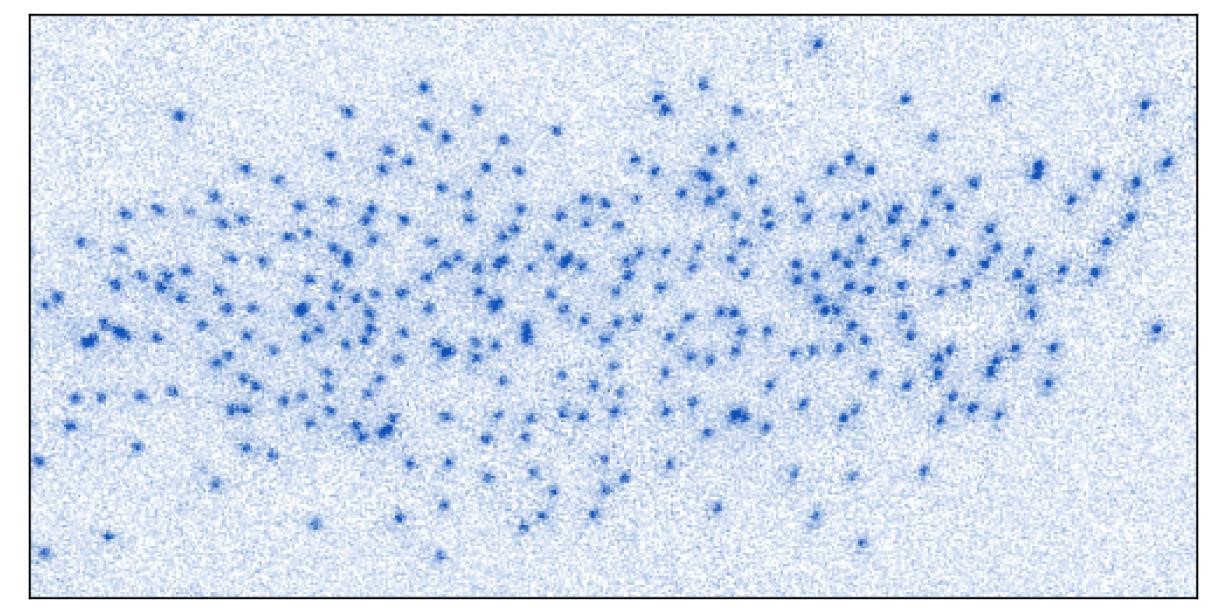Follow us on Google News (click on ☆)
Electrons, protons, and neutrons, which make up the main building blocks of the matter around us, have one thing in common: they are fermions. These particles possess a very unique property, namely that it is absolutely impossible to find two of them in the same physical state.

Figure:
Image of a configuration of a fermionic quantum gas. Each blue dot represents a single atom. Instead of clustering together, the atoms avoid each other due to the Pauli exclusion principle, so that on average, these points arrange themselves differently from a set of randomly placed points (the overall elliptical shape of the cloud is due to the geometry of the potential in which the atoms are trapped).
© Tim de Jongh et al., Phys. Rev. Lett. 2025.
This characteristic of fermions is called the Pauli exclusion principle, named after the famous physicist Wolfgang Pauli, who formulated it explicitly exactly a century ago, earning him the Nobel Prize twenty years later. This rule, observed but not proven, is constitutive of quantum mechanics and is essential for understanding the world around us.
Thus, it is what prevents matter from collapsing, explains the properties of semiconductors, and dictates the structure of the periodic table.
However, since the Pauli principle concerns extraordinarily small energy and length scales, it had until now only been observed indirectly, through the effects it induces at the more macroscopic scales of matter.
In a study published recently, scientists from the Kastler Brossel Laboratory (LKB, CNRS/Collège de France/ENS-PSL/Sorbonne Université) have revealed the clearest images ever made of the Pauli exclusion principle directly in action at atomic scales. They used clouds of hundreds of 6Li atoms (fermions) cooled to temperatures close to absolute zero.
These low temperatures make the quantum properties of the particles observable, which would otherwise be masked by their thermal agitation. The team used a technique they recently developed to image quantum waves. By first letting the atoms evolve freely in space, and then immobilizing them in an optical lattice—microscopic "cages" regularly spaced and created by laser light—the scientists were able to directly take a photograph of the fermionic system, recording the position of each atom.
This procedure directly revealed the Pauli exclusion principle "in action," as statistical analyses of the configurations show that the atoms avoid each other and give a statistical signature in perfect agreement with what quantum theory predicts.
In the system they studied, the Pauli exclusion was the only possible interaction between the atoms, revealing its effects in the purest way imaginable.
The team examined correlations between the positions of two and three particles, revealing a significant decrease in the number of pairs and triplets of atoms found at short distances from each other, a property called the "Pauli hole" and considered an unambiguous signature of the principle of the same name.
Thanks to their technique, researchers can now study significantly more complicated systems, such as assemblies of strongly interacting fermions, where the Pauli exclusion principle competes with particle collisions. By being able to take direct images of their gas configurations, this method will allow them to measure the behavior of fermionic systems so complex that even the most powerful supercomputers cannot simulate them.
This work was selected as an Editor's Suggestion in Physical Review Letters, where it is published on the cover. It was also reviewed in the APS journal Physics.
Doi: 10.1103/PhysRevLett.134.183403
Open archives: arXiv